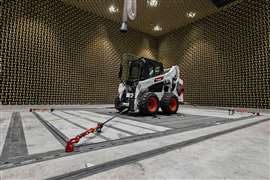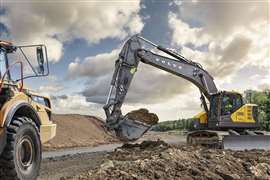Read this article in 中文 Français Deutsch Italiano Português Español
Agtonomy brings practical automation to agriculture
08 October 2025
They say you need to walk a mile in another person’s shoes to truly understand what they’re going through. In Tim Bucher’s case, he’s literally walked acres in the shoes of the farmers his company is seeking to serve – partly because he’s a farmer himself.
 Tim Bucher, founder and CEO, Agtonomy
Tim Bucher, founder and CEO, Agtonomy
Bucher, founder and CEO of software automation company Agtonomy, grew up in the ag industry, even starting his own vineyard operation, Trattore Farms (“trattore” is Italian for “tractor”), at the tender age of 16. Later graduating with an engineering degree from UC-Davis, he went on to work for such Silicon Valley giants as Steve Jobs, Michael Dell and Bill Gates.
“I’ve worked and been credited on some iconic products like the iPad and Xbox and things that have really been great consumer shifts,” he stated. “But I was always farming at the same time, and a lot of people didn’t even know that while I was doing it.”
Over the last 10 years, Bucher saw profits at Trattore Farms starting to level off amid a variety of labor-related factors, including regulations that reduced allowable overtime hours and the general struggle to attract workers into the agricultural industry.
Consequently, Bucher automated most aspects of the farm, but realized he’d neglected the one area that needed it most – the field work. So, he and some friends worked to develop an autonomous tractor prototype, which he then showed to some Silicon Valley colleagues.
“I said, ‘Look what I’m doing to save my farm.’ And they said, ‘Tim, you’re an idiot. This is not just about Trattore; this is about saving the world. Let’s build a company and let’s make this happen.’”
Agtonomy was subsequently founded in 2021, consisting of Bucher and a team of growers and technology experts. It’s objective: to bring practical automation to agriculture.
“That’s why we started and that’s why we exist – to help us save all these growers,” said Bucher.
Getting physical with AI
Agtonomy is unique in that it focuses on what’s called physical AI (artificial intelligence).
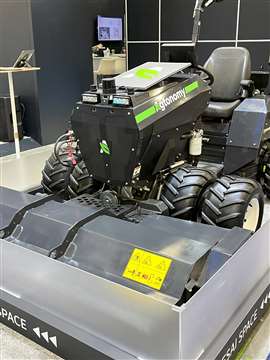 Agtonomy’s software platform was purpose-built for equipment used in permanent crops as well as ground maintenance. (Photo: Becky Schultz)
Agtonomy’s software platform was purpose-built for equipment used in permanent crops as well as ground maintenance. (Photo: Becky Schultz)
“You hear a lot about AI these days, but the way AI interacts with physical objects, whether it’s humanoids or whether it’s other kinds of robots – and we consider autonomous tractors to be robots – it’s kind of a whole new category of AI that’s really exploding right now,” Bucher said.
Rather than build tractors itself, Agtonomy provides software and services to help existing OEMs in industrial markets accelerate their digital transformations by bringing physical AI to reality on their machines.
To that end, the company launched its third-generation Agtonomy Platform for agriculture and land management earlier this year. Formerly known as Telefarmer, the latest update introduces enhanced fleet intelligence powered by physical AI; new equipment platform support for mixed fleets; and expanded capabilities for diverse crops, turf and open-field operations.
According to the company, the platform combines GPS guidance, vision-based navigation and physical AI to automate repetitive fieldwork while enabling real-time visibility and control via a user-friendly app. The software is currently available on compact and mid-size tractors ranging from 45 to 112 hp, and can be used for tasks such as mowing, spraying, weeding and hauling across a range of permanent (specialty) crops and terrain.
Purpose-built platform
Agtonomy’s software platform was purpose-built for permanent crops (those not in rotation) such as fruit and nut trees and vineyards as well as ground maintenance.
“[Permanent] crops are very high value,” Bucher noted. “Each one of those trees… if you damage that, it’s thousands of dollars because it’s taken a long time to mature. And you’re dealing with these rows where you’re within one inch of the crop itself.”
These crops are much harder to manage and require substantially more labor than traditional crops, meaning farmers feel the labor pinch even more intensely.
“If you’re solving for some of these issues, you want to solve them for where the impact is the greatest and there’s a lot more vehicles involved. You have opportunity to really help be a game changer for those kinds of growers,” said Bucher.
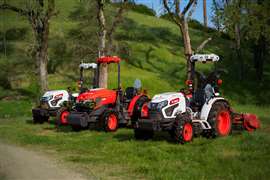 To maximize its impact, Agtonomy is currently working with Tier 1 OEMs, including Bobcat and Kubota, with a global market presence. (Photo: Agtonomy)
To maximize its impact, Agtonomy is currently working with Tier 1 OEMs, including Bobcat and Kubota, with a global market presence. (Photo: Agtonomy)
Given the nature of permanent crops, which often grow to produce a “tunnel” of foliage through which machines must move, limited visibility to the sky can impact the use of GPS. “So, what we do is a lot of computer vision to exploit the structure of the crop itself in order to navigate very carefully through that crop and, more importantly, farm precisely around that crop,” Bucher explained. “We took a very different approach at the time, and it really helped accelerate us as a leader in that space.”
He went on to point out that such farming is not solely centered around navigation from one point in a field to another. “If you navigate from point A to point B and you do an incorrect spray, you can kill the entire crop. You have to think of autonomous ag vehicles in the context of the vehicle itself and the implement, and you have to make sure that the workload that you’re doing with that implement is done correctly.
“We looked at the whole solution and I think that’s where our farming background really came into play because we knew you’re not just going to do navigation,” said Bucher. “You need to spray properly, and you need to make sure you check that. So, it all kind of ties into a much bigger solution.”
While currently targeted to permanent crops, there are plans to expand into additional crops and industries in future.
True collaboration
As with various other vehicle forms, agricultural tractors are being transitioned to drive-by-wire systems incorporating electrohydraulic valves that enable higher-level compute control to be embedded into the machines. To facilitate the move to automation, Agtonomy offers these OEMs a reference design for a sensor kit.
“Sensors include things like cameras, lidar, inertial measurement units, wheel odometry and other kinds of things that are plugged into the tractor at [the] factory,” said Bucher. “We can basically get [OEMs] operating with this reference design that they can tweak. We help them with placement so that we can see everything properly with our computer systems and all the safety is there.”
In some cases, OEMs can have a fully autonomous proof of concept vehicle in weeks, said Bucher, though more time is required for final testing, integration, safety, etc., before the equipment reaches the factory floor.
“It is a true collaboration,” he continued. “We work directly with our partners’ engineering teams, who are incredible – we cannot do what they do. And we hope we accelerate them in the things that we do that they don’t necessarily have the internal folks for yet.”
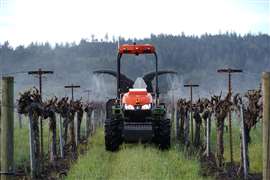 In June 2025, Kubota North America partnered with Agtonomy to commercialize autonomous operations on Kubota diesel tractors for spraying and mowing. (Photo: Kubota North America)
In June 2025, Kubota North America partnered with Agtonomy to commercialize autonomous operations on Kubota diesel tractors for spraying and mowing. (Photo: Kubota North America)
Tier 1 target
Because it’s still in startup mode, Agtonomy has chosen to limit its current focus to Tier 1 OEMs with a global presence.
“If you really want to make impact in this industry, don’t start a company to build machines. Partner with those who already have the capability to build thousands of machines a day and, more importantly, to get them distributed and supported in the world,” Bucher advised. “It’s really about working with these companies that already have the brand, the trust, the dealer network, the parts, the service – all the things you need to keep these industrial businesses going and growing.”
Agtonomy-enabled vehicles are already being manufactured in its partners’ factories, which Bucher said is a huge milestone for his company and for the OEMs, as well. One of the longest standing partnerships is with Doosan Bobcat, dating back to February 2023, first as a collaboration and expanded later that summer when Bobcat chose to make a strategic investment in Agtonomy.
“Bobcat’s really well known for construction equipment, but the reality is Bobcat actually started as a company in agriculture,” said Bucher. “They really are a global leader in compact [equipment] – whether that’s track loaders or skid steers or excavators or even compact tractors… They have a line of compact tractors called the CT line. We’ve been embedded in that line in the 50-hp range.”
In June 2025, Kubota North America announced it had become Agtonomy’s latest OEM partner. It is integrating the agtech company’s software platform with Kubota AI-based crop insights, with the goal to commercialize autonomous operations on Kubota diesel tractors for spraying and mowing.
“Both Kubota and Bobcat are well known around the globe when it comes to permanent crops,” Bucher said. “Both companies… bring an incredible drive by wire vehicle, and then we help them bring an automation kit together on that.
“Our software runs on the vehicle, they manufacture it, and we help them get that out into the fields to test customers and then to commercial customers.”
More autonomy ahead
Though high-value permanent crops are its “beachhead,” Bucher sees potential for Agtonomy-enabled vehicles in broad acre agriculture, as well.
Such large-scale agriculture has historically called for big tractors capable of covering many acres at once. But such machines are heavy, causing a lot of ground compaction, and their higher horsepower engines come with a weighty price tag, Bucher noted.
“If you’re buying a 900-hp engine… for the same price you could buy twenty 100-hp engines or more,” he asserted.
“The reason these tractors have grown so big is because one person needed to do a lot more. But now, if you can have fully autonomous capabilities, you don’t need these big tractors anymore because you can do what we call ‘broad acre swarming.’ For less cost, you can have more vehicles doing more work in parallel. And if any mechanical issue comes up, you have redundancy. A grower is not sitting there [because their] 900-hp tractor is down for two days because the parts have to come in.
“So, there are many benefits there. That’s a big part of the future just within ag,” said Bucher.
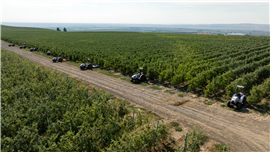 Lower horsepower autonomous tractors could eventually expand into broad acre swarming applications, reducing costs and providing redundancy in such operations. (Photo: Agtonomy)
Lower horsepower autonomous tractors could eventually expand into broad acre swarming applications, reducing costs and providing redundancy in such operations. (Photo: Agtonomy)
Looking beyond ag, he pointed to expanded use in ground maintenance and turf management, as well as environmental volatility events such as wildfires and even warehouse logistics.
“Construction is a little harder because a construction site changes so frequently,” said Bucher. “But there are certain jobs that are repeatable, whether it’s digging a ditch for a long way or maybe loading up a big pile of dirt continuously.”
Yet, he contended that permanent crops remain one of the most difficult environments, which is why it’s so important to tackle that first.
“You’re literally doing dynamic obstacle avoidance every second... so your technology has to be really, really, really good. So, if you think about this sort of concentric circle, if you get autonomy done right in one of these industrial markets… that can now expand out into other markets, which in most cases are easier than that [use] case,” he stated.
Given the potential, Agtonomy is “super excited” about the future – for itself and for its partners.
“With [our OEM partners] and many others that you know of, as well, they don’t just focus on one market segment. They have zero-turn mowers for turf, they have construction equipment, they have ag equipment, they have forklifts... So, it’s kind of this autonomous revolution, if you will, that we’re just at the beginning of,” Bucher asserted.
“The future is bright for not just these OEMs, but ultimately for those end customers who are desperate for this – who know it’s the only way they can save their businesses.”
POWER SOURCING GUIDE
The trusted reference and buyer’s guide for 83 years
The original “desktop search engine,” guiding nearly 10,000 users in more than 90 countries it is the primary reference for specifications and details on all the components that go into engine systems.
Visit Now
STAY CONNECTED




Receive the information you need when you need it through our world-leading magazines, newsletters and daily briefings.
CONNECT WITH THE TEAM











